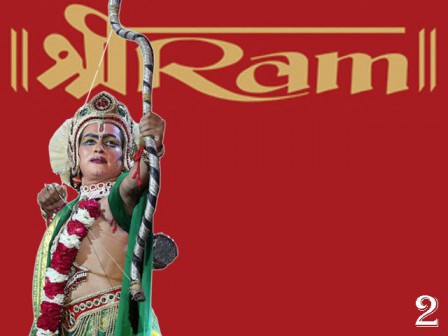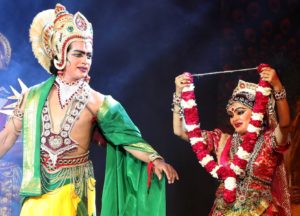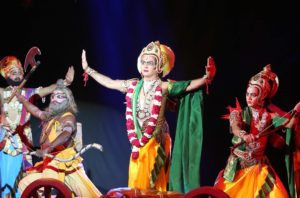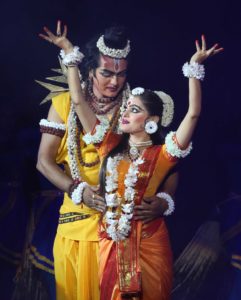The wheel of karma and the call of dharma

Shobha Deepak Singh
The original Ramayana was composed many epochs ago by Sage Valmiki along with later by Tulsidas’ Ramcharitmanas. This sacred scripture is the cornerstone of the Hindu faith. Ramayana documents Rama’s triumph over demon king Ravana, thereby enacting his fate as the ideal man and incarnation of Lord Vishnu.
On one level, Rama’s journey is an allegory for the journey every soul must make. In becoming human Rama shared in our human suffering and enacted the drama of our own, lives — each of us endures our own banishment, our own loss, faces our own disillusions, and hopes eventually to learn acceptance of our lot and to find ultimate redemption. Thus to hear or to witness Rama’s struggles is to relive our own lives but in a divine context. Each episode in the story is multi-layered, working through individual karma or destiny and the divine lila or the play of Rama.
The central theme of Ramayana is the wheel of karma; the consequences of past deeds. The basic plot of Ramayana is a simple struggle between good and evil. But it does not remain simple. There are many layers of karma involved and dilemmas to be faced and that the gap between good and evil is not as clear as we might have thought and that behind this simple story lies a cosmic purpose to be fulfilled. At every step along the way we are tested emotionally and intellectually.
Rama’s banishment is the first great hurdle. When his stepmother makes her extravagant demand for Rama to be exiled, we wonder why he should submit to such a scheme. But Ram insists it is his duty to do as he is ask no matter how far-fetched that request may. It is a matter of principle. There are greater forces at work.
Dashratha has his own karma to answer to. When he was a young man he carelessly killed ‘Shravan Kumar’ and was cursed by his blind parents to die separated from his son. He had pledged to Kaikeyi when he married her, in addition to her two wishes, that her son could be the king. Unknown to us, these consequences are being carried by Dashratha in exactly the way we might be carrying unknown consequences from our own past. Ram’s destiny as the incarnation of Vishnu requires him to leave Ayodhya for his eventual confrontation and vanquishing of Ravana.
A central theme of Ramayana is the sacrifice of freedom for the sake of duty or honour. In Hindu society, this manifests as a set of principles governing behaviour such as the duty to obey one’s father. These principles governing the lives of the characters in Ramayana might seem oppressive in a modern context yet at a higher level, they embody a spirit of service that can be an expression of love. Love, if it is to be more than sentiment, demands service.
Rama’s devotion to Sita and his people – both dharma – are in the higher sense an expression of love demanding the sacrifice of his personal freedom. This sacrifice of freedom is made not only by Rama but by all the divine characters of Ramayana. Each exemplify the ideal of service in a particular relationship. Hanumana as a devotee, Lakshmana as a brother and Sita as a wife.
In the world of Ramayana, there is no escaping dharma which is each persons’ path to salvation. And when one duty appears to conflict with another as when Rama’s love for Sita conflicts with his duty to his people, Rama and each one of us is tested. The ever present background to Ramayana is the forest. The beauty of the forest is woven through out Ramayana in luxuriant passages of detailed imagery.
But forest life is not easy as Rama warns Sita at the outset. It represents the ideal of simple living and renunciation of the world which is the corner stone of the Vedic spiritual path. The forest could be interpreted as the womb from which all life emerges and into which all will return.
The commencing passage of Valmiki’s Ramayana tells us how, in a state of dismay, he composed a verse that gave expression to his emotion. This verse became the model for the entire epic poem of Ramayana, the thread that runs throughout it and which cannot be escaped: ‘Hunter! Because you have so cruelly destroyed the happiness of these birds your happiness will also be destroyed’. Allegorically, Sita’s tribulations, in suffering separation from her lord express the unconscious feelings of all souls separated from God in this world. To rediscover this inner sense of loss, of being separated from God, is the essence of the spiritual path of devotion to God.
I regularly used to watch the story of ‘Rama’ enacted on stage, but when at last I turned to Tulsidas’s original text, in its English translation, I was overwhelmed by its beauty and depth, which brought many realisations in my heart. I hope that by putting Valmiki’s and Tulsidas story into modern Hindi and making it accessible to a wider audience, I have helped others to savour something of the flavour of the original Ramayana and gain from it the inspiration I myself found.
Tomorrow: Time and space encapsulated in the Ramayana




